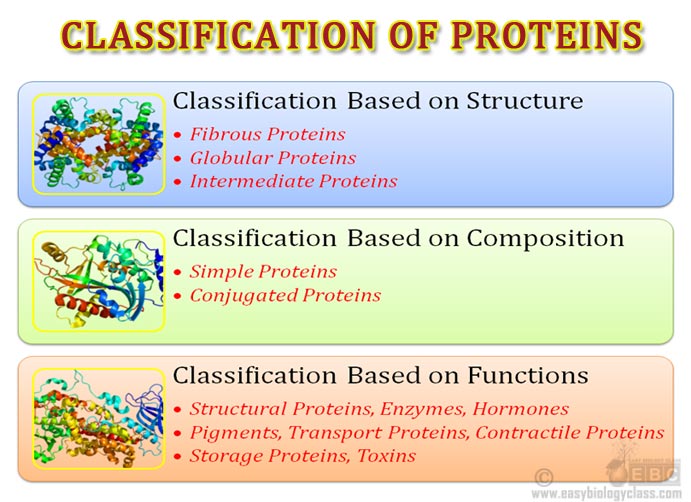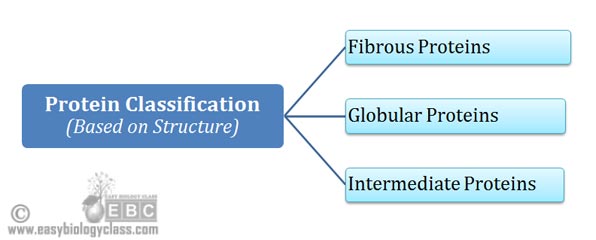Classification of proteins: Proteins are important macromolecules of the cells, formed by the polymerization of amino acids according to the sequence of genetic code in the mRNA. Proteins are the mode of expression of the genetic information. They perform a variety of duties in the cells such as they act as the structural components of cells, enzymes, hormones, pigments, storage proteins and some toxins in the cells. The proteins are classified into many categories based on different criterions.
Criterion for the classification of proteins:
Ø Proteins are classified based on the following THREE criterion:
(I). Classification based on STRUCTURE of Protein
(II). Classification based on COMPOSITION of Protein
(III). Classification based on FUNCTIONS of Proteins
(I). Classification of Proteins based on the Structure of Proteins
Ø Based on the structure, proteins are classified into 3 groups.
(A). Fibrous Proteins
(B). Globular Proteins
(C). Intermediate Proteins
Classification of Proteins

(A). Fibrous Proteins
Ø They are linear (long fibrous) in shape.
Ø Secondary structure is the most important functional structure of fibrous proteins.
Ø Usually, these proteins do not have tertiary structures.
 Ø Physically fibrous proteins are very tough and strong.
Ø Physically fibrous proteins are very tough and strong.
Ø They are insoluble in the water.
Ø Long parallel polypeptide chains cross linked at regular intervals.
| You may also like NOTES in... | ||
|---|---|---|
| BOTANY | BIOCHEMISTRY | MOL. BIOLOGY |
| ZOOLOGY | MICROBIOLOGY | BIOSTATISTICS |
| ECOLOGY | IMMUNOLOGY | BIOTECHNOLOGY |
| GENETICS | EMBRYOLOGY | PHYSIOLOGY |
| EVOLUTION | BIOPHYSICS | BIOINFORMATICS |
Ø Fibrous proteins form long fibres or sheaths.
Ø Functions of fibrous proteins: perform the structural functions in the cells.
Ø Examples of fibrous proteins: Collagen, Myosin, Silk and Keratin.
(B). Globular Proteins
Ø Globular proteins are spherical or globular in shape.
Ø The polypeptide chain is tightly folded into spherical shapes.
Ø Tertiary structure is the most important functional structure in globular proteins.
Ø Physically they are soft than fibrous proteins.
Ø They are readily soluble in water.
Ø Most of the proteins in the cells belong to the category of globular proteins.
Ø Functions: Form enzymes, antibodies and some hormones.
Ø Example: Insulin, Haemoglobin, DNA Polymerase and RNA Polymerase
(C). Intermediate Proteins
Ø Their structure is intermediate to linear and globular structures.
Ø They are short and more or less linear shaped proteins
Ø Unlike fibrous proteins, they are soluble in water.
Ø Function: blood clotting proteins
Ø Example: Fibrinogen
 (II). Classification of Proteins based on Composition:
(II). Classification of Proteins based on Composition:
Ø Two broad categories of proteins according to its composition, they are:
(A). Simple Proteins
(B). Conjugated Proteins
(A). Simple Proteins
Ø Simple proteins composed of ONLY amino acids.
Ø Proteins may be fibrous or globular.
Ø They possess relatively simple structural organization.
Ø Example: Collagen, Myosin, Insulin, Keratin
(B). Conjugated Proteins
Ø Conjugated proteins are complex proteins.
Ø They contain one or more non-amino acid components.
Ø Here the protein part is tightly or loosely bound to one or more non-protein part(s).
Ø The non-protein parts of these proteins are called prosthetic groups.
Ø The prosthetic group may be metal ions, carbohydrates, lipids, phosphoric acids, nucleic acids and FAD.
Ø The prosthetic group is essential for the biological functions of these proteins.
Ø Conjugated proteins are usually globular in shape and are soluble in water.
Ø Most of the enzymes are conjugated proteins.
Ø Based on the nature of prosthetic groups, the conjugated proteins are further classified as follows:
$ Phosphoprotein: Prosthetic group is phosphoric acid, Example- Casein of milk, Vitellin of egg yolk.
$ Glycoproteins: Prosthetic group is carbohydrates, Example – Most of the membrane proteins, Mucin (component of saliva).
$ Nucleoprotein: Prosthetic group is nucleic acid, Example – proteins in chromosomes, structural proteins of ribosome.
$ Chromoproteins: Prosthetic group is pigment or chrome, Example: Haemoglobin, Phytochrome and Cytochrome.
$ Lipoproteins: Prosthetic group is Lipids, Example: Membrane proteins
$ Flavoproteins: Prosthetic group is FAD (Flavin Adenine Dinucleotide), Example: Proteins of Electron Transport System (ETS).
$ Metalloproteins: Prosthetic group is Metal ions, Example: Nitrate Reductase.

(III). Classification of Protein based on Functions:
(A). Structural Proteins:
Ø Form the component of the connective tissue, bone, tendons, cartilage, skin, feathers, nail, hairs and horn.
Ø Most of them are fibrous proteins and are insoluble in water.
Ø Example: Collagen, Keratin and Elastin.
 (B). Enzymes:
(B). Enzymes:
Ø They are the biological catalysts.
Ø Enzymes reduce the activation energy of reactants and speed-up the metabolic reactions in the cells.
Ø Most of them are globular conjugated proteins
Ø Example: DNA Polymerase, Nitrogenase, Lipase
(c). Hormones:
Ø They include the proteinaceous hormones in the cells.
Ø Example: Insulin, Glucagon, ACH
(D). Respiratory Pigments
Ø They are coloured proteins
Ø All of them are conjugated proteins and they contain pigments (chrome) as their prosthetic group.
Ø Example: Haemoglobin, Myoglobin
| You may also like... | ||
|---|---|---|
| NOTES | QUESTION BANK | COMPETITIVE EXAMS. |
| PPTs | UNIVERSITY EXAMS | DIFFERENCE BETWEEN.. |
| MCQs | PLUS ONE BIOLOGY | NEWS & JOBS |
| MOCK TESTS | PLUS TWO BIOLOGY | PRACTICAL |
(E). Transport Proteins
Ø They transport the materials in the cells
Ø They form channels in the plasma membrane
Ø They also form one of the components of blood and lymph in animals.
Ø Example: Serum albumin
(F). Contractile proteins
Ø They are the force generators of muscles
Ø They can contract with the expense of energy from ATP molecules.
Ø Example: Actin, Myosin
(G). Storage Proteins
Ø They act as the store of metal ions and amino acids in the cells.
Ø Found in seeds, egg and milk
Ø Abundantly seen in pulses (legume seeds).
Ø Example: Ferritin which stores iron, Casein, Ovalbumin, Gluten of Wheat
(F). Toxins
Ø They are toxic proteins
Ø Example: Snake venom
You may also like…

 (II). Classification of Proteins based on Composition:
(II). Classification of Proteins based on Composition:
well elaborated.
thank you
keep visiting easy biology class
This is good
Thank you
Clear concept
Very very useful for my examination
simple and elaborate content forv quick learners
This is excellent
Clear concept and very helpful…😊❤
content is clear thank you
Thank you
Keep visit http://www.easybiologyclass.com